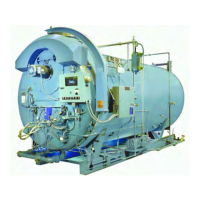Chapter 3 — Waterside Care and Requirements
3-2 Part No. 750-184
A. GENERAL
The operator should be familiar with Chapter 3 before attempting to
place the unit into operation.
Although it is of prime importance, the subject of water supply and
treatment cannot adequately be covered in this manual. For specific
information or assistance with your water treatment requirements,
contact your Cleaver-Brooks service and parts representative.
Feedwater equipment should be checked and ready for use. Be sure
that all valves, piping, boiler feed pumps, and receivers are installed
in accordance with prevailing codes and practices.
Water requirements for both steam and hot water boilers are
essential to boiler life and length of service. It is vital that care be
taken in placing the pressure vessel into initial service. The
waterside of new boilers and new or remodeled steam or hot water
systems may contain oil, grease or other foreign matter. A method
of boiling out the vessel to remove the accumulations is described
later in Chapter 3.
Boilers, as a part of a hot water system, require proper water
circulation. The system must be operated as intended by its
designer in order to avoid thermal shock or severe, possibly
damaging, stresses from occurring to the pressure vessel.
Note: This manual only covers boilers using water. Glycol solutions
have different operating requirements, circulation rates and
temperatures, etc.
B. WATER REQUIREMENTS
1. HOT WATER BOILER
Air Removal
The hot water outlet includes a dip tube which extends 2 to 3 inches
into the boiler. The dip tube reduces the possibility of air, which may
be trapped at the top of the shell, from entering into the system.
Oxygen or air released in the boiler will collect or be trapped at the
top of the boiler shell.
The air vent tapping on the top center line of the boiler should be
piped into the expansion or compression tank. Air trapped at the top
of the boiler will find its way out of the boiler through the tapping.
Minimum Water Temperature - The minimum recommended boiler
water temperature is 170°F. When water temperatures lower than
170°F are used, the combustion gases are reduced in temperature
to a point where water vapor condenses, causing corrosion in the
boiler and possible breeching.
Condensation is more severe on a unit that operates intermittently
and which is greatly oversized for the actual load. Condensation can
be minimized by maintaining boiler water temperatures above
170°F.

